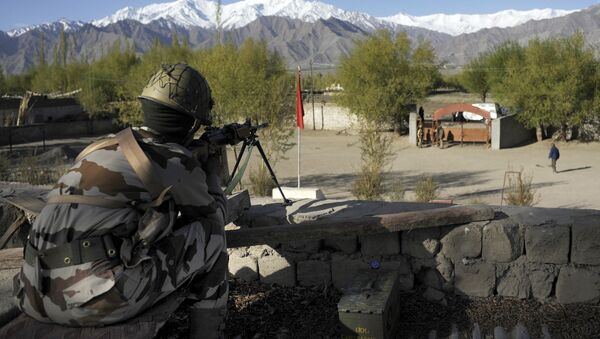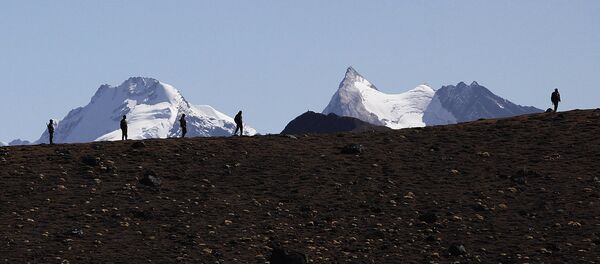Chinese and Indian senior military officials agreed to peacefully resolve the situation in the border zone following consultations on 13 June.
The move comes after tensions escalated in May, resulting in several skirmishes and the deployment of additional forces to the Line of Actual Control (LAC) that roughly acts as the border between the two countries.
India's Foreign Ministry noted that the sides maintain ties, and the atmosphere at the meeting was friendly and good neighbourly. The statement also said that peace and tranquillity at the border are crucial for the overall development of bilateral relations.
India's Defence Minister Rajnath Singh confirmed that the sides wanted to resolve the border confrontation in Ladakh through military and diplomatic negotiations, the Hindustan Times reported.
The minister said that military talks are underway to resolve the disagreement. He noted that India would not compromise with national pride as it was no longer a “weak nation”.
“Our strength has multiplied”, said the minister, adding that India is increasing its strength to secure the country and not to intimidate anyone.
This show of muscle-flexing on the border with China is connected with the domestic political situation in India, an expert at the Institute of Asian and African Studies at Moscow State University, Boris Volkhonsky told Sputnik.
“The Indian government needs to show the domestic audience that it remains strong, will not compromise national interests, will not cede territory. In this regard, there is a double game. In India itself, there are very radical voices about the need for a strong backlash against China and accusations of government weakness. They recall that Modi has been to China far more often than all the prime ministers before him combined. He has been to China five times as Prime Minister and four times as Chief Minister of Gujarat. And when he first ran for the elections, he didn't deny that he would follow China's example in many ways”, Volkhonsky says.
However, according to the expert, it was clear from the very beginning that neither side wanted to go escalate to full-scale hostilities.
“The Indian muscle-flexing is primarily intended to show its willingness to defend its national interests”, Volkhonsky concludes.
The Asia Pacific Daily indicated that on the day when China and India's military agreed on efforts to de-escalate tensions, China announced a large-scale PLA military exercise on the Northwest plateau.
The CCTV military channel showed how thousands of paratroopers, large consignments of equipment and supplies were moved from Hubei Province to the Northwest plateau by various transport vehicles, APD informed.
The Chinese media platform cited CCTV, which noted that combat training demonstrates "China's ability to quickly strengthen its border defence when necessary."
In an interview with Sputnik, an analyst from the People's University of China, Zhou Rong, noted that China's military activity in the northwest is a reaction to the situation on the border with India.
The 76th Group Army of the Chinese People's Liberation Army recently launched field training in the Kunlun Mountains at an altitude of over 4,000 meters.
According to Zhou Rong, their purpose is to test the ability to quickly move combat units, especially the air force, to prepare personnel to combat in conditions of severe cold, testing the combat capabilities of modern equipment, including tanks, anti-tank missiles and infantry fighting vehicles.
“This is the primary force of the PLA in securing the western border areas. The exercises are aimed at the ability to use combat transport capabilities. Apart from airlifting of contingent-owned equipment, this time forces and equipment, especially large equipment such as tanks and other tracked armoured vehicles, were quickly transported by rail to the site of the exercise”, she says.
The Chinese expert believes that there is no doubt that the drills are related to the Indian factor:
“India has recently provoked tensions several times in the Ladakh area and these provocations are becoming increasingly widespread. At the same time, a large number of troops are deployed on India's northern border, that is, in an area close to Pakistani-controlled Kashmir, and China. According to the video-information, India is still pulling its troops towards the northern border, including the main battle tanks T-90 and T-72, and a large number of fighter jets. This poses a serious security threat on the Sino-Indian border in Xinjiang and Tibet”.
Zhou Rong also believes that China's military drills in the Northwest plateau are being held against the backdrop of the Indian defence minister's statement on Kashmir, and attempts to rely on US support against China:
“This statement by India's Defence Minister Singh that the population in the Pakistani-controlled part of Kashmir will soon demand that the area be part of India is particularly to be noted. Furthermore, some forces in India are strongly influenced by the ideas of expansionism and hegemony. They expect to strengthen their beliefs with US support”.
Under these circumstances, China is conducting large-scale exercises in the northwestern region to show that China is not afraid of confrontation, the expert says.
“We are not willing to cause trouble but we are not cowards. Furthermore, China also needs to express its support for Pakistan as the current Indian threat to Pakistan is becoming more and more evident. We must be vigilant enough to be able to respond to India's expansionism”, Zhou Rong stresses.
Baijiaohao also reported that India's mountain units do not have electronic warfare equipment. In other words, they are not capable of conducting counterintelligence, electronic suppression and electronic protection, the platform notes.
It also cites the opinion of senior Indian military leaders, who admit that India is at a disadvantage due to its lack of electronic warfare capability.



